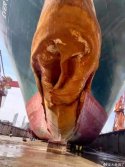You are using an out of date browser. It may not display this or other websites correctly.
You should upgrade or use an alternative browser.
You should upgrade or use an alternative browser.
Chinese shipbuilding industry
- Thread starter tphuang
- Start date
huge if true. ammonia diesels = possibility of renewable hydrogen being used for ships.There is going to be a big market for LNG duel fuel refits on existing ships.
Ever Given is in a Chinese shipyard getting repairs. Someone took the opportunity to photograph the damaged bulb of the ship.
https://www.reddit.com/r/CatastrophicFailure/comments/qkzxfx

https://www.reddit.com/r/CatastrophicFailure/comments/qkzxfx

Her assets are bigger than the ship's anchor...
In any case the LNG is only green if the carbon is sequestered... but slippage methane emissions is a problem
With these latest orders, China's position as the leading shipbuilding nation in terms of production output is cemented. China currently has a 43.3% share of the global orderbook (see chart 3) having held the number one spot continuously since 2017. In 2020, China produced 41% of the World's ships by GT with this figure expected to rise to 45% for 2021 (see Chart 4).
Well Japan was overtaken by S Korea, but even S Korea with its mega shipbuilding ability is no longer number one...
I hope this wasn't posted previously.
Cape Nagloynyn contracts take shape
08 November 2021The Chinese shipbuilder Wison Heavy Industry will provide the hulls for the Cape Nagloynyn floating nuclear power plant, according to a report by TASS. The rated power of the plant has also dropped since its first announcement.
.jpg?ext=.jpg)
Wison's shipyard for floating energy platforms in Nantong, China (Image: Wison)
Citing Russian public procurement websites, TASS said Wison will provide the hulls to Rosatom subsidiary Atomenergomash by October 2023 and February 2024. The Chinese builder was selected after Russian shipyards were too busy to complete the order in time. Its Nantong shipyard, 135 kilometres from Shanghai, also produce platforms for floating LNG facilities and for floating wind turbines.
Atomenergomash will receive the barges and fit each one with two pressurised water reactors. Another Rosatom subsidiary, Atomflot, is responsible for delivering the final floating power plants to the Arctic site of Cape Nagloynyn. The first should be in operation by 2027, in time to power a new port and the entire infrastructure of the Baimskaya copper and gold mine. All four reactors are slated to be in position and operational by the start of 2031, providing a total of 212 MWe.
TASS gave some details from the contract between Atomenergomash and Wison. The barges will include containment shells as well as gas- and water-tight storage for liquid and solid radioactive waste. The 'autonomy' of the units will be supported by stocks of fresh water lasting 20 days and food for two months. An emergency diesel generator and boiler will have a 30-day supply of fuel.
Hm with this, can we then expect the 004 carrier to still be conventional powered?
Cape Nagloynyn contracts take shape
08 November 2021
The Chinese shipbuilder Wison Heavy Industry will provide the hulls for the Cape Nagloynyn floating nuclear power plant, according to a report by TASS. The rated power of the plant has also dropped since its first announcement.
.jpg?ext=.jpg)
Wison's shipyard for floating energy platforms in Nantong, China (Image: Wison)
Citing Russian public procurement websites, TASS said Wison will provide the hulls to Rosatom subsidiary Atomenergomash by October 2023 and February 2024. The Chinese builder was selected after Russian shipyards were too busy to complete the order in time. Its Nantong shipyard, 135 kilometres from Shanghai, also produce platforms for floating LNG facilities and for floating wind turbines.
Atomenergomash will receive the barges and fit each one with two pressurised water reactors. Another Rosatom subsidiary, Atomflot, is responsible for delivering the final floating power plants to the Arctic site of Cape Nagloynyn. The first should be in operation by 2027, in time to power a new port and the entire infrastructure of the Baimskaya copper and gold mine. All four reactors are slated to be in position and operational by the start of 2031, providing a total of 212 MWe.
TASS gave some details from the contract between Atomenergomash and Wison. The barges will include containment shells as well as gas- and water-tight storage for liquid and solid radioactive waste. The 'autonomy' of the units will be supported by stocks of fresh water lasting 20 days and food for two months. An emergency diesel generator and boiler will have a 30-day supply of fuel.
And 005 and onwards nuclear then. Also the 004 being conventional probably wouldn't be that bad.
4 carriers in near waters being conventional (001 might just be training carrier mainly), with 2 having emals.
huge if true. ammonia diesels = possibility of renewable hydrogen being used for ships.
Methanol is also being explored by Maersk, Mitsui OSK Lines etc but I guess in the methanol vs ammonia race ammonia is currently ahead
